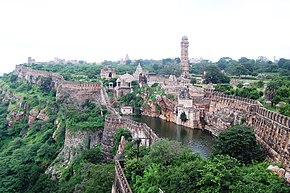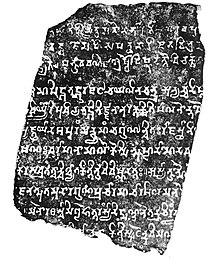| Revision as of 09:19, 15 May 2024 editCycloneYoris (talk | contribs)Extended confirmed users, Page movers, New page reviewers, Pending changes reviewers, Rollbackers83,797 edits →Decline of Mori Kingdom: fix.← Previous edit | Revision as of 11:06, 25 June 2024 edit undo103.110.48.62 (talk) as per the source given. please verify.Next edit → | ||
| Line 28: | Line 28: | ||
| ] | ] | ||
| The '''Mori''' was a kingdom that ruled over southwestern ] and northern ] from the 7th century and for a period of about 120 years.<ref>{{cite book |last1=Somani |first1=ram Vallabh |title=History Of Mewar |date=1976 |page=28 |url=https://archive.org/details/in.ernet.dli.2015.143000/page/n33/mode/2up}}</ref> They controlled the ]. The Mori Rajputs were probably the most powerful power in this region before the rise of the ]. |
The '''Mori''' was a kingdom that ruled over southwestern ] and northern ] from the 7th century and for a period of about 120 years.<ref>{{cite book |last1=Somani |first1=ram Vallabh |title=History Of Mewar |date=1976 |page=28 |url=https://archive.org/details/in.ernet.dli.2015.143000/page/n33/mode/2up}}</ref> They controlled the ]. The Mori Rajputs were probably the most powerful power in this region before the rise of the ]. They are considered as the branch of later Mauryans.<ref>{{Cite book|last=Shukla|first=Dinesh Chandra|url=https://books.google.com/books?id=w_oJAQAAIAAJ|title=Early History of Rajasthan|publisher=Bharatiya Vidya Prakashan|year=1978|location=Delhi|pages=185–186|language=en|quote=In the seventh century or in the beginning of the eighth century, the Mauryas, evidently the same as the Mori Rajputs, had a strong principality in S.E. Rajasthan}}</ref><ref>{{Cite book|last=Sharma|first=Dasharatha|url=https://books.google.com/books?id=W1dXAAAAMAAJ&q=Mauryas|title=Rajasthan Through the Ages: From the earliest times to 1316 A.D|publisher=Rajasthan State Archives|year=1966|pages=226–228|language=en}}</ref> | ||
| ==History== | ==History== | ||
Revision as of 11:06, 25 June 2024
Ancient Indian clan
| This article may require copy editing for grammar, style, cohesion, tone, or spelling. You can assist by editing it. (July 2023) (Learn how and when to remove this message) |
| Mori Rajputs | |||||||||
|---|---|---|---|---|---|---|---|---|---|
| 700_734 CE. | |||||||||
 South Asia South Asia600 CE KUNDINASPALLAVASALUPASNEZAKSALCHONSKALINGASPANDUVAMSHISGAUDASHAILODBHAVASGONANDASKANNAUJTAKKAWESTERN TURKSTOCHARIANSVALABHISINDHMANDAVYA- PURALATER GUPTASTHANESARCHALUKYASEARLY KALA- CHURISPERSIAN EMPIREThe Moris and neighbouring South Asian polities circa 600 CE. | |||||||||
| Capital | Chittorgarh Fort, Rajasthan, India 24°53′11″N 74°38′49″E / 24.8863°N 74.647°E / 24.8863; 74.647 | ||||||||
| Religion | State religion: | ||||||||
| |||||||||


The Mori was a kingdom that ruled over southwestern Rajasthan and northern Malwa from the 7th century and for a period of about 120 years. They controlled the Chittor Fort. The Mori Rajputs were probably the most powerful power in this region before the rise of the Gurjara-Pratihara dynasty. They are considered as the branch of later Mauryans.
History
The Mori Rajputs are mentioned as one of the thirty-five branches of the Parmar Rajput clan by British scholars. Chitrangada Mori, a Mori Rajput ruler, laid the foundation of the fort of Chittorgarh.
A dynasty belonging to the Mori clan controlled the Chittor Fort and the surrounding region before the Guhila dynasty. The fort of Chittor was a well established citadel in the 8th century under the Moris. The Chittorgarh inscription dated 713 AD gives four names of Mori Rajput rulers of Chittor.
The Chittorgarh inscription dated 713 AD gives four names of Mori Rajput rulers of Chittor. Manuraja is identified with Māna, mentioned in the Chittorgarh Māna-sarovara inscription of 713 AD. Māna was described as the son of Bhoja. Māna's great - grandfather was named Maheśvara.
Bappa probably led the Mori campaign against the Arabs, which made him more famous than his overlord. Later, he either deposed Manuraja and became the king of Chittor with the help of the nobles or became the king after Manuraja died childless. The Moris were expelled from Chittorgarh by Bappa Rawal.
Defeat by the Arabs
According to C.K. Majumdar, the Moris were ruling at Chittor when the Arabs (mlechchhas) invaded north-western India around 725 CE. The Arabs defeated the Moris, and in turn, were defeated by a confederacy that included Bappa Rawal.
Decline of Mori Kingdom
King Maan Mori was defeated by Bappa Rawal. Bappa Rawal, defeated his maternal grandfather and captured the kingdom of Chittor. This event is mentioned in the Rajprashasti Abhilekh, in the epic Mahakavya, in Canto 3.
As per yet another saying, the last king of Mori Dynasty of Chittor was Maan Singh Mori who fought against Arabs (mlechchhas) invasion north-western India around 725 CE. Muhammad bin Qasim who was an Arab military commander in service of the Umayyad Caliphate, attacked Chittor via Mathura. Bappa Rawal, of guhilote (Sisodia) dynasty, was a commander in Mori army. After defeating Bin Qasim, Bappa Rawal obtained Chittor in dowry from Maan Singh Mori in 734 A.D. Then onwards Chittor is ruled by Sisodia Rajputs. Still descendents of Chitrangada Mori are surviving in the Malwa region of India.
See also
References
- Parameswaran, Dr S. Pari (13 January 2023). ANCIENT AND MEDIEVAL HISTORY: AN EAGLE'S VIEW FOR CIVIL SERVICES AND OTHER EXAMS. MJP Publisher. ISBN 978-93-5528-240-8.
- ^ Guides, Bluworlds; Das, Joydip. Royal Rajasthan Pocket Travel Guide. Bluworlds Guides.
- Schwartzberg, Joseph E. (1978). A Historical atlas of South Asia. Chicago: University of Chicago Press. pp. 21, 147. ISBN 0226742210.
- Balogh, Dániel (9 December 2018). "Chittorgarh fragmentary inscriptions of the Naigamas, inked rubbing". doi:10.5281/zenodo.2105017.
{{cite journal}}: Cite journal requires|journal=(help) - Epigraphia Indica Vol 34. pp. 53–58.
- Somani, ram Vallabh (1976). History Of Mewar. p. 28.
- Shukla, Dinesh Chandra (1978). Early History of Rajasthan. Delhi: Bharatiya Vidya Prakashan. pp. 185–186.
In the seventh century or in the beginning of the eighth century, the Mauryas, evidently the same as the Mori Rajputs, had a strong principality in S.E. Rajasthan
- Sharma, Dasharatha (1966). Rajasthan Through the Ages: From the earliest times to 1316 A.D. Rajasthan State Archives. pp. 226–228.
- Chand, Faquir; Sinha, N. K. (1992). People of India: Daman and Diu. Popular Prakashan. ISBN 978-81-7154-762-3.
- Singh Chib, Sukhdev (1979). Rajasthan. The University of Michigan. p. 118.
- Rajasthan. The University of Michigan. 1962. p. 44.
- India Tourism Development Corporation, India Tourism Development Corporation (1975). Guide to Rajasthan. India Tourism Development Corporation. p. 169.
- ^ Rajasthan State Gazetteer, Rajasthan State Gazetteer (1995). Rajasthan State Gazetteer: History and culture. Directorate, District Gazetteers, Government of Rajasthan. p. 322.
- ^ Calcutta Sanskrit College Research Series, Calcutta Sanskrit College Research Series (1965). Calcutta Sanskrit College Research Series. The University of California. p. 52.
- ^ Kumar, Raj (2008). Encyclopaedia Of Untouchables : Ancient Medieval And Modern. Gyan Publishing House. ISBN 978-81-7835-664-8.
- Singh, R.B (1975). Origin of the Rajputs. Sahitya Sansar Prakashan. p. 40.
- Shyam Manohar Mishra 1977, p. 48.
- Topsfield, Andrew (2001). Court Painting at Udaipur Art Under the Patronage of the Maharanas of Mewar. Artibus Asiae Publishers. p. 17. ISBN 9783907077030.
- ^ R. C. Majumdar 1977, p. 298-299.
- Ram Vallabh Somani 1976, p. 45.
- Khalid Yahya Blankinship 1994, p. 188.
- Bhatt, Ranchod (1973). Rajprasastia Mahakavyam.
- Ranchod Bhatt Maharana (1973). Raj Singh Raj Prashasti.
- indianrajputs.com/history. sfn error: no target: CITEREFindianrajputs.com/history (help)
Bibliography
- Khalid Yahya Blankinship (1994). The End of the Jihad State: The Reign of Hisham Ibn 'Abd al-Malik and the Collapse of the Umayyads. SUNY Press. p. 188. ISBN 978-0-7914-1827-7.
- Ram Vallabh Somani (1976). History of Mewar, from Earliest Times to 1751 A.D. Mateshwari. OCLC 2929852.
- R. C. Majumdar (1977). Ancient India. Motilal Banarsidass. ISBN 9788120804364.
- Shyam Manohar Mishra (1977). Yaśovarman of Kanauj. Abhinav. OCLC 557679616.
| Clans of the Rajput people | |
|---|---|
| Suryavanshi | |
| Chandravanshi | |
| Agnivanshi | |
| Subclans | |
| Subdivision Clans | |
This article about an Indian ethnicity or social group is a stub. You can help Misplaced Pages by expanding it. |